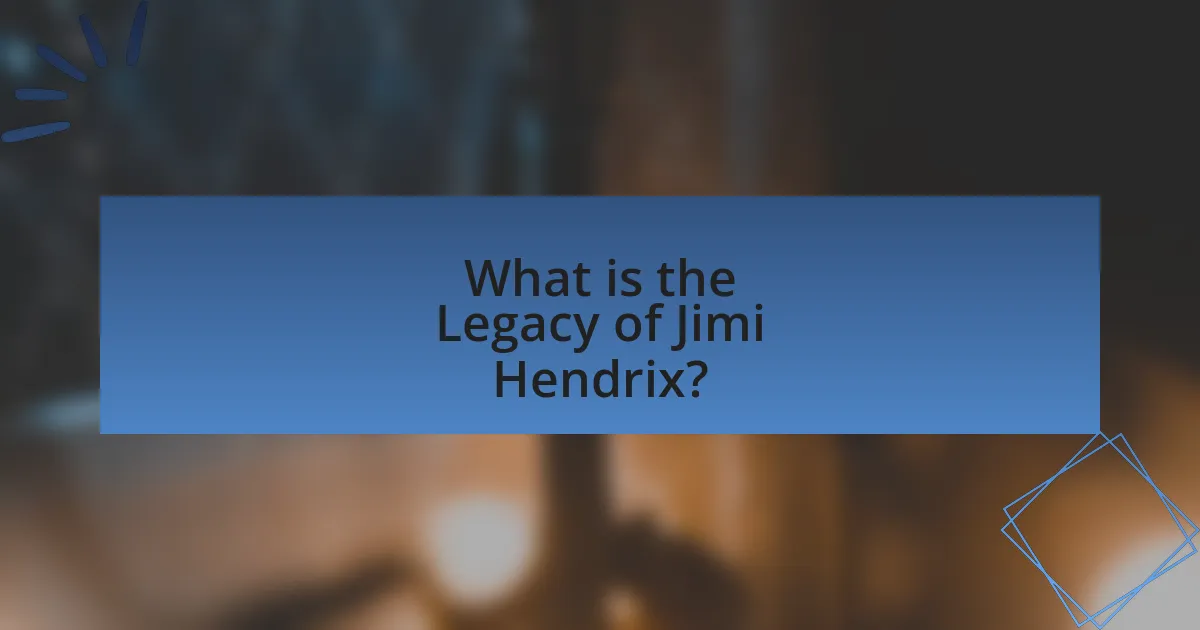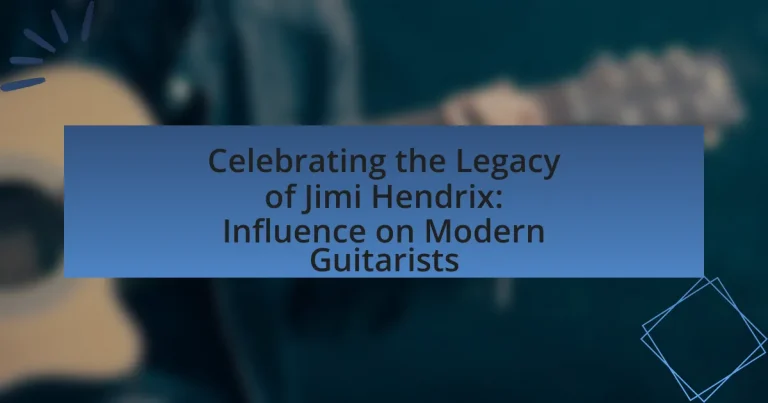The article focuses on the legacy of Jimi Hendrix, highlighting his revolutionary impact on rock music and guitar playing. It details how Hendrix transformed the electric guitar’s role through innovative techniques such as feedback, distortion, and unique chord voicings, which have become foundational in modern guitar music. The piece also explores Hendrix’s influence on contemporary guitarists, his cultural significance during the 1960s, and the lasting effects of his style on various music genres. Additionally, it provides practical tips for aspiring guitarists to incorporate Hendrix’s techniques into their practice.

What is the Legacy of Jimi Hendrix?
The legacy of Jimi Hendrix is defined by his revolutionary impact on rock music and guitar playing. Hendrix transformed the electric guitar’s role in popular music, introducing innovative techniques such as feedback, distortion, and the use of the whammy bar, which have become standard in modern guitar playing. His iconic performances, particularly at the Woodstock Festival in 1969, showcased his extraordinary skill and creativity, influencing countless musicians across genres. Hendrix’s albums, including “Are You Experienced” and “Electric Ladyland,” are considered masterpieces that pushed the boundaries of music production and songwriting. His unique blend of blues, rock, and psychedelia has inspired generations of guitarists, solidifying his status as one of the greatest guitarists of all time.
How did Jimi Hendrix revolutionize guitar playing?
Jimi Hendrix revolutionized guitar playing by introducing innovative techniques and effects that transformed the instrument’s role in music. He popularized the use of feedback, distortion, and wah-wah pedals, allowing for a new range of sounds and expressions. His iconic performances, such as the rendition of “The Star-Spangled Banner” at Woodstock in 1969, showcased his ability to manipulate sound and create emotional depth, influencing countless guitarists. Hendrix’s unique approach to chord voicings and improvisation also expanded the harmonic possibilities of the guitar, setting a new standard for future musicians.
What techniques did Hendrix introduce to the guitar world?
Jimi Hendrix introduced several groundbreaking techniques to the guitar world, including feedback manipulation, the use of distortion, and innovative chord voicings. Feedback manipulation allowed him to create sustained notes and unique soundscapes, which became a hallmark of his style. His use of distortion transformed the electric guitar’s sound, making it a central element in rock music. Additionally, Hendrix’s innovative chord voicings, such as the use of 7th and 9th chords, expanded harmonic possibilities for guitarists. These techniques significantly influenced the development of rock and blues guitar playing, shaping the sound of modern music.
How did Hendrix’s style differ from his contemporaries?
Hendrix’s style differed from his contemporaries through his innovative use of feedback, distortion, and unconventional chord progressions. While many guitarists of the 1960s adhered to traditional blues and rock structures, Hendrix incorporated elements of psychedelia and funk, creating a unique sound that emphasized improvisation and emotional expression. His pioneering techniques, such as playing with his teeth and behind his back, showcased a theatrical flair that set him apart. Additionally, Hendrix’s mastery of the electric guitar allowed him to manipulate tone and texture in ways that were unprecedented at the time, influencing countless modern guitarists and reshaping the landscape of rock music.
Why is Jimi Hendrix considered a cultural icon?
Jimi Hendrix is considered a cultural icon due to his revolutionary impact on music, particularly in the realm of rock and guitar playing. His innovative techniques, such as feedback manipulation and the use of distortion, transformed the electric guitar’s role in popular music. Hendrix’s performances, characterized by flamboyant stage presence and groundbreaking improvisation, set new standards for live music. His album “Are You Experienced,” released in 1967, is often cited as one of the greatest albums of all time, showcasing his unique blend of blues, rock, and psychedelia. Additionally, Hendrix’s influence extends beyond music; he became a symbol of the counterculture movement of the 1960s, representing freedom, creativity, and social change.
What impact did Hendrix have on music and society during his time?
Jimi Hendrix significantly transformed music and society during his time by revolutionizing guitar playing and influencing the cultural landscape of the 1960s. His innovative use of feedback, distortion, and unconventional techniques redefined rock music, making him a pivotal figure in the genre. Hendrix’s performances, characterized by his flamboyant style and technical prowess, inspired countless musicians and set new standards for live shows. Additionally, his music addressed social issues, reflecting the counterculture movement, and resonated with themes of peace and love during a tumultuous era marked by the Vietnam War and civil rights struggles. His iconic songs, such as “Purple Haze” and “The Star-Spangled Banner,” became anthems of the time, further solidifying his impact on both music and societal change.
How has Hendrix’s image influenced popular culture?
Hendrix’s image has significantly influenced popular culture by embodying the spirit of the 1960s counterculture and revolutionizing the perception of rock music. His flamboyant style, characterized by vibrant clothing and dramatic performances, set a precedent for artistic expression in music, inspiring countless artists across various genres. For instance, his iconic performance at Woodstock in 1969, where he famously covered “The Star-Spangled Banner,” not only showcased his innovative guitar techniques but also became a symbol of protest and social change during the Vietnam War era. This event solidified his status as a cultural icon, influencing musicians like Prince and Kurt Cobain, who adopted similar bold aesthetics and attitudes in their work. Additionally, Hendrix’s approach to guitar playing, including the use of feedback and distortion, has left a lasting impact on the sound and style of modern rock music, shaping the way guitarists express themselves creatively.

How has Jimi Hendrix influenced Modern Guitarists?
Jimi Hendrix has profoundly influenced modern guitarists through his innovative techniques and unique sound. His use of feedback, distortion, and unconventional chord progressions has inspired countless musicians to explore new sonic possibilities. For instance, Hendrix popularized the use of the wah-wah pedal and the fuzz effect, which have become staples in contemporary guitar playing. Additionally, his approach to improvisation and stage presence has set a standard for live performances, encouraging guitarists to express themselves more freely and energetically. The impact of Hendrix’s style can be seen in the work of artists such as Stevie Ray Vaughan and John Mayer, who cite him as a major influence in their own guitar playing.
What specific techniques have modern guitarists adopted from Hendrix?
Modern guitarists have adopted several specific techniques from Jimi Hendrix, including the use of feedback, string bending, and innovative chord voicings. Feedback, which Hendrix famously utilized to create sustain and texture, has become a staple in rock and blues guitar playing. String bending, a technique Hendrix mastered to express emotion and create unique melodic lines, is widely emulated by guitarists across genres. Additionally, Hendrix’s use of unconventional chord voicings, such as the dominant seventh chords and altered chords, has influenced modern guitarists to explore more complex harmonic structures. These techniques are evident in the playing styles of contemporary artists like John Mayer and Gary Clark Jr., who incorporate these elements into their music, showcasing Hendrix’s lasting impact on guitar playing.
How do modern guitarists incorporate feedback and distortion like Hendrix?
Modern guitarists incorporate feedback and distortion like Hendrix by utilizing advanced effects pedals, amplifiers, and techniques that emulate his signature sound. They often use overdrive and fuzz pedals to achieve a saturated tone, similar to Hendrix’s use of the Fuzz Face. Additionally, they manipulate feedback through controlled volume settings and strategic placement of their amplifiers to create sustained notes and harmonics, mirroring Hendrix’s innovative feedback techniques. For instance, guitarists like Jack White and John Mayer have cited Hendrix as an influence, employing similar methods to produce expressive, dynamic sounds that pay homage to his legacy.
What role does improvisation play in the styles of contemporary guitarists influenced by Hendrix?
Improvisation is central to the styles of contemporary guitarists influenced by Jimi Hendrix, as it embodies the spontaneous creativity and emotional expression that Hendrix exemplified in his performances. Contemporary guitarists, such as Joe Satriani and John Mayer, often incorporate improvisational techniques to create unique solos and adapt their playing to live settings, reflecting Hendrix’s approach to blending technical skill with emotional depth. This improvisational element allows these musicians to explore new musical ideas and connect with their audience in real-time, mirroring Hendrix’s legendary live performances where he frequently deviated from structured compositions to showcase his innovative guitar work.
Who are some notable guitarists influenced by Jimi Hendrix?
Notable guitarists influenced by Jimi Hendrix include Eric Clapton, Stevie Ray Vaughan, and Prince. Eric Clapton has acknowledged Hendrix’s impact on his playing style and musical approach, particularly in the use of feedback and distortion. Stevie Ray Vaughan often cited Hendrix as a primary influence, incorporating his techniques and improvisational style into his own performances. Prince, known for his innovative guitar work, has also expressed admiration for Hendrix, drawing inspiration from his flamboyant stage presence and guitar prowess. These guitarists exemplify Hendrix’s lasting influence on the evolution of modern guitar playing.
What elements of Hendrix’s style can be seen in the music of these guitarists?
Hendrix’s style is characterized by innovative use of feedback, distortion, and a unique approach to rhythm and phrasing, which can be seen in the music of modern guitarists like John Mayer and Joe Satriani. John Mayer incorporates Hendrix’s blues-infused rock sound and expressive bends, while Joe Satriani utilizes similar feedback techniques and complex chord progressions. Both guitarists reflect Hendrix’s improvisational spirit and ability to blend genres, showcasing his lasting influence on their musical expressions.
How have these guitarists paid tribute to Hendrix in their work?
Many guitarists have paid tribute to Jimi Hendrix by incorporating his innovative techniques and stylistic elements into their own music. For instance, artists like Stevie Ray Vaughan and Joe Satriani have emulated Hendrix’s use of feedback and distortion, showcasing these elements in their solos and compositions. Vaughan’s album “Texas Flood” features guitar work that reflects Hendrix’s improvisational style, while Satriani’s “Surfing with the Alien” includes nods to Hendrix’s melodic phrasing and dynamic range. Additionally, numerous guitarists have covered Hendrix’s iconic songs, such as “Purple Haze” and “Little Wing,” further solidifying his influence in their repertoires. These acts of homage highlight Hendrix’s lasting impact on the guitar world and demonstrate how contemporary musicians continue to celebrate his legacy through their artistry.
What are the lasting effects of Hendrix’s influence on guitar music today?
Jimi Hendrix’s influence on guitar music today is profound, shaping techniques, styles, and the overall approach to guitar playing. His innovative use of feedback, distortion, and effects pedals has become foundational in rock music, inspiring countless guitarists to explore new sonic possibilities. For instance, his iconic song “Purple Haze” showcases his pioneering use of the wah-wah pedal, which has since become a staple in modern guitar playing. Additionally, Hendrix’s blending of genres, particularly rock, blues, and psychedelia, has encouraged contemporary musicians to experiment with diverse musical influences, leading to the emergence of various subgenres. His emphasis on improvisation and expressive playing continues to resonate, as seen in the work of modern guitarists like Joe Satriani and John Mayer, who cite Hendrix as a key influence in their development.
How do modern guitarists view Hendrix’s contributions to music?
Modern guitarists view Jimi Hendrix’s contributions to music as revolutionary and foundational to the development of electric guitar techniques. They recognize his innovative use of feedback, distortion, and unconventional chord progressions, which have influenced countless genres, particularly rock and blues. For instance, guitarists like John Mayer and Joe Satriani have cited Hendrix as a primary influence, often referencing his ability to blend technical skill with emotional expression. Additionally, Hendrix’s pioneering approach to live performances and stage presence set a standard that modern musicians strive to emulate, solidifying his status as a pivotal figure in music history.
What are some common themes in songs by guitarists influenced by Hendrix?
Common themes in songs by guitarists influenced by Hendrix include exploration of love and relationships, social and political commentary, and personal introspection. Guitarists such as Stevie Ray Vaughan and Eric Clapton often incorporate emotional depth in their lyrics, reflecting on love’s complexities and struggles. Additionally, many songs address societal issues, echoing Hendrix’s own activism, as seen in tracks like “Voodoo Child” and “All Along the Watchtower.” Personal introspection is also prevalent, with artists using their music to convey vulnerability and self-discovery, mirroring Hendrix’s own lyrical style. These themes collectively showcase the profound impact Hendrix had on the songwriting approaches of subsequent guitarists.
How has Hendrix’s legacy shaped the evolution of guitar genres?
Hendrix’s legacy has profoundly shaped the evolution of guitar genres by introducing innovative techniques and a unique sound that redefined the instrument’s role in music. His use of feedback, distortion, and unconventional chord progressions expanded the sonic possibilities of the guitar, influencing rock, blues, and even jazz genres. For instance, his iconic performance of “The Star-Spangled Banner” at Woodstock in 1969 showcased his ability to blend musical styles and techniques, inspiring countless guitarists to explore new creative avenues. Additionally, Hendrix’s emphasis on improvisation and expressive playing has become a foundational element in modern guitar music, impacting artists across various genres, including heavy metal and funk.
What practical tips can aspiring guitarists learn from Jimi Hendrix’s style?
Aspiring guitarists can learn several practical tips from Jimi Hendrix’s style, including the use of feedback, chord embellishments, and innovative finger techniques. Hendrix famously utilized feedback to create expressive sounds, demonstrating how to manipulate the guitar’s natural resonance for emotional impact. Additionally, he often incorporated chord embellishments, such as adding 7ths and 9ths, which enriched his harmonic palette and provided a unique sound. His finger techniques, including thumb-over-the-neck chords and intricate fingerpicking, showcase the importance of versatility and creativity in playing. These elements not only define Hendrix’s signature style but also serve as essential tools for guitarists aiming to develop their own musical voice.
How can beginners incorporate Hendrix’s techniques into their practice?
Beginners can incorporate Hendrix’s techniques into their practice by focusing on his signature use of chord embellishments, feedback manipulation, and innovative use of effects. Practicing chord voicings such as the 7#9 chord, commonly known as the “Hendrix chord,” allows beginners to emulate his unique sound. Additionally, experimenting with feedback by positioning the guitar close to the amplifier can help beginners understand how Hendrix created his iconic tones. Using effects like fuzz, wah-wah, and univibe can further enhance their sound, as Hendrix frequently utilized these to achieve his distinctive style. By integrating these elements into their practice routines, beginners can effectively capture the essence of Hendrix’s guitar techniques.
What resources are available for learning Hendrix-inspired guitar techniques?
Resources for learning Hendrix-inspired guitar techniques include instructional books, online courses, video tutorials, and guitar tabs. Notable books such as “Jimi Hendrix: The Ultimate Experience” by John McDermott provide insights into his techniques and style. Online platforms like TrueFire and JamPlay offer courses specifically focused on Hendrix’s playing style, while YouTube features numerous tutorials from guitarists analyzing his techniques. Additionally, websites like Ultimate Guitar provide extensive tabs for Hendrix’s songs, allowing learners to practice his iconic riffs and solos. These resources collectively facilitate a comprehensive understanding of Hendrix’s unique approach to guitar playing.


